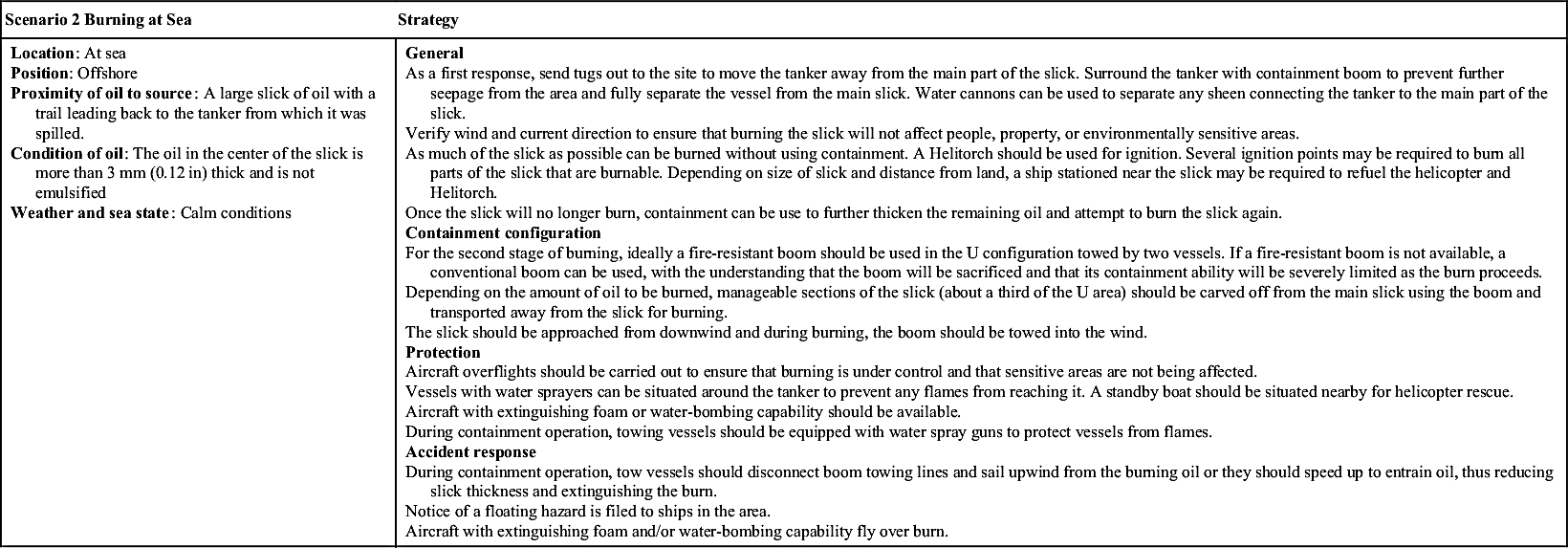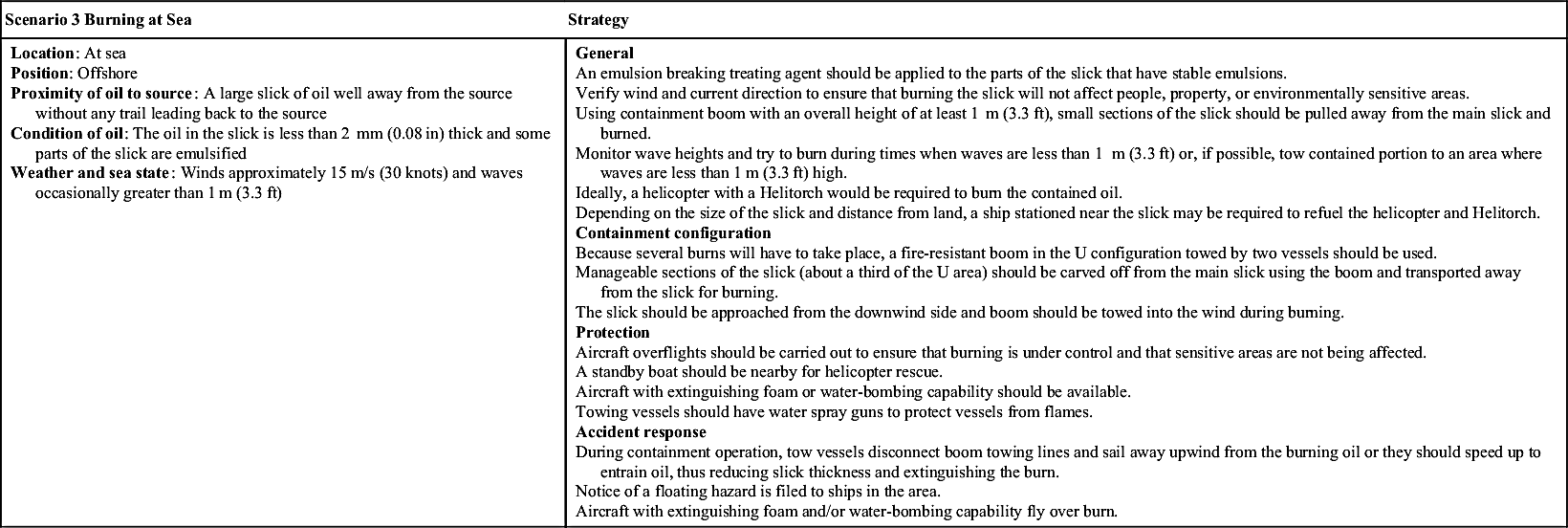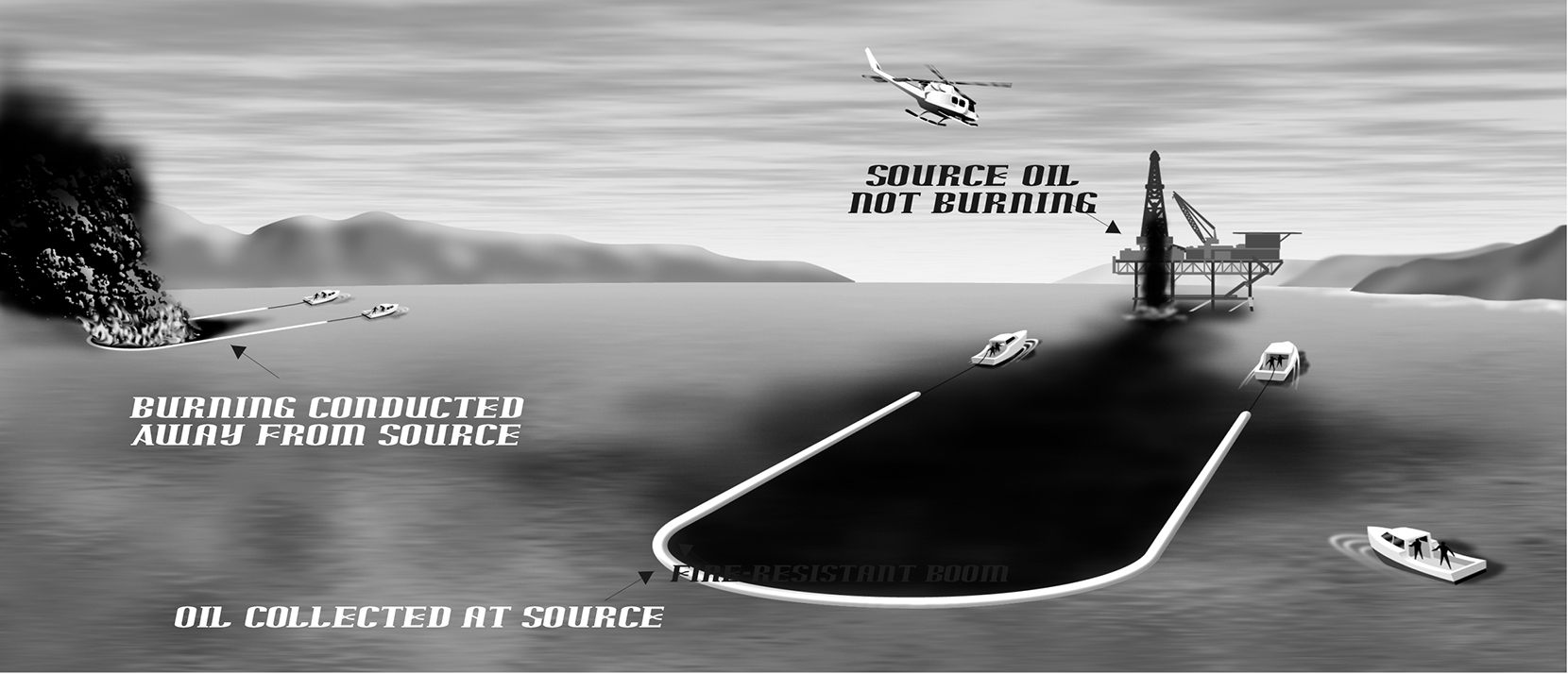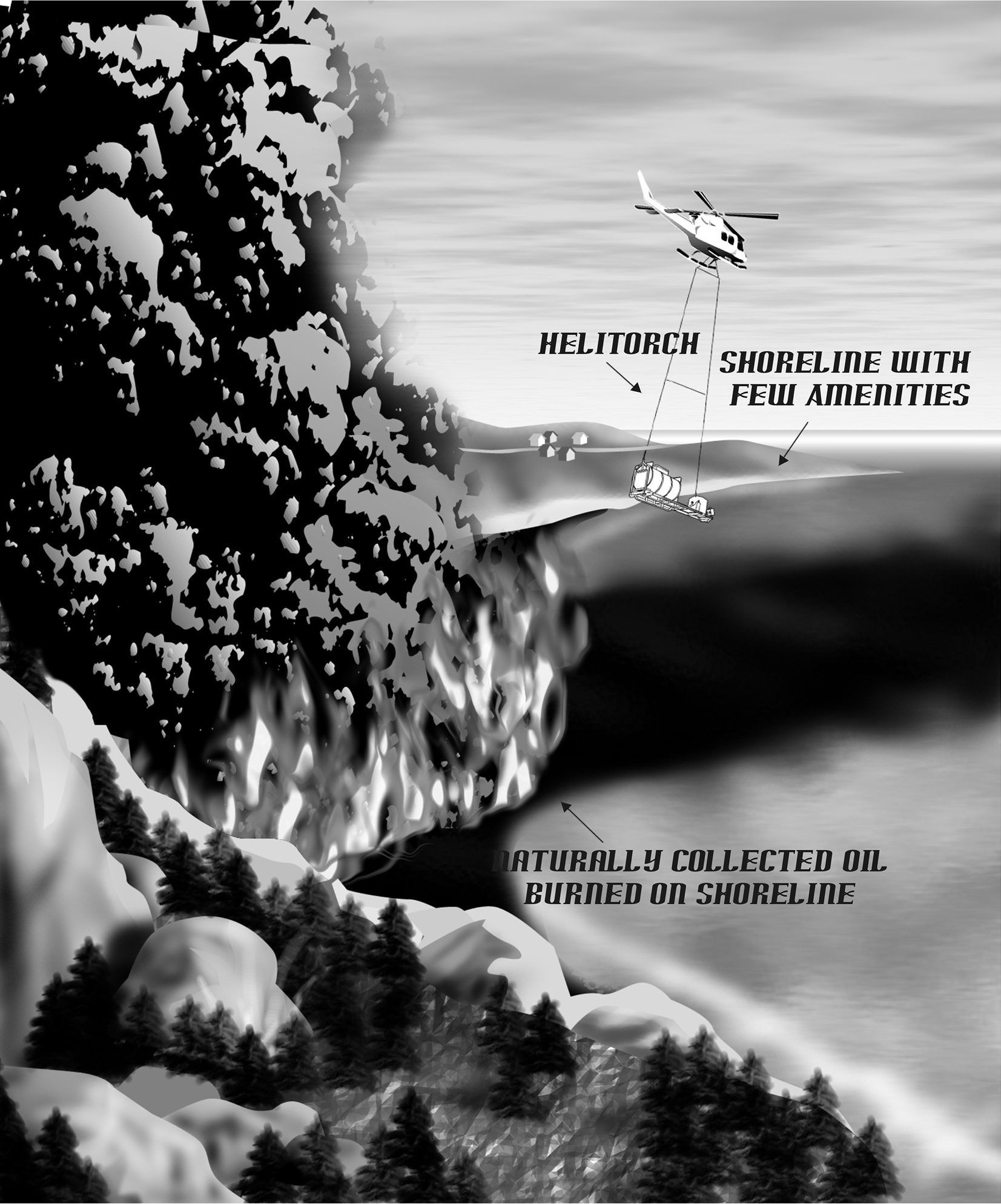10.11. Possible Spill Situations
As no two oil spill situations are the same, it is helpful to look at several possible scenarios when developing response techniques for spill situations: burning at sea, burning in a protected bay, burning on a river, burning in melt pools in the Arctic, and burning in an intertidal zone [84].
The strategies listed in Table 10.18 can best be implemented using specific tactics. These tactics are illustrated separately in Figs. 10.84–10.93 and summarized in Table 10.19. Each of these tactics has specific advantages and limitations [84].
The well-known tactic of using towed fire boom to collect and burn oil directly in the boom is shown in Fig. 10.84 [84]. As with all booms, this technique has a relative current limitation of 0.4 m/s (0.7 knots) before oil is lost under or over the boom. This can be overcome on the open ocean by towing at the relative velocity, despite the surface current. This means that if the actual current exceeds 0.4 m/s (0.7 knots), the boom tow could be slipping down current. Another limitation of this method is that the fire could propagate to the source of the oil or endanger the tow boats and their crew.
Collecting the oil separately, towing the boom away from a nonburning source, and then burning the oil is shown in Figs. 10.85 and 10.86. This approach prevents the fire from spreading to the oil source. Another advantage is that the oil can be collected using a conventional boom and then transferred to a fire-resistant boom for actual burning. Since fire-resistant boom is more expensive and harder to deploy than conventional boom, this option has some practical and economic benefits. The use of towed boom to protect amenities from a burning source of oil is shown in Fig. 10.87. Using anchored boom to burn oil is shown in Fig. 10.88. This tactic poses no risk to tow boats and their crew. The boom may not maintain correct alignment with the wind and current, however, and the relative velocity of the surface current and the boom are also considerations.
The use of anchored deflection boom to direct oil away from amenities or toward burn areas is shown in Fig. 10.89. The burning of oil against shoreline is shown in Fig. 10.90. This can only be done if there is no combustible material such as trees and buildings on the shoreline. In addition, highly adhesive oil residue may be left on the shoreline, which may be difficult to remove. Burning oil in ice is illustrated in Fig. 10.91. The natural containment of ice can serve to thicken oil sufficiently for ignition and burning to take place. This technique has often been used to burn oil spills in the Arctic.
Oil can be contained in shallow water using a temporary steel boom as shown in Figs. 10.92 and 10.63. The boom is constructed of corrugated steel sheets and metal stakes. As a portion of the corrugated steel is in the water, heat is dissipated and the sheet metal should remain intact long enough for the oil to be burned. It is important to stress that this method has not been extensively tested and backups should be in place in case of failure.
Table 10.18
Specific Spill Scenarios and Burning Strategies
| Scenario 1 Burning at Sea | Strategy |
Location: At sea Position: Offshore Proximity of oil to source: A large slick of oil well away from the source without any trail leading back to the source Condition of oil: The oil in the center of the slick is more than 3 mm (0.12 in) thick and is not emulsified Weather and sea state: Calm conditions | General Verify wind and current direction to ensure that burning the slick will not affect people, property, or environmentally sensitive areas. As a first response, as much of the slick as possible can be burned without using containment. This will require a helicopter with a Helitorch. Several ignition points may be required to burn all parts of the slick that are burnable. Depending on the size of the slick and distance from land, a ship stationed near the slick may be required to refuel the helicopter and Helitorch. Once the slick will no longer burn, containment can be used to further thicken the remaining oil and attempt to burn it again. Containment configuration For the second stage of burning, ideally a fire-resistant boom should be used in the U configuration towed by two vessels. If a fire-resistant boom is not available, a conventional boom can be used with the understanding that the boom would be sacrificed and that its containment ability will be severely limited as the burn proceeds. Depending on the amount of oil to be burned, manageable sections of the slick (about 1/3 of the boom's U area) should be carved off from the main slick using the boom and transported away from the slick for burning. The slick should be approached from downwind and the boom should be towed into the wind during burning. Protection Aircraft overflights should be carried out to ensure that burning is under control and that sensitive areas are not being affected. A standby boat should be nearby for helicopter rescue. Aircraft with extinguishing foam or water-bombing capability should be available. During containment operation, towing vessels should have water spray guns ready to protect them from flames. Accident response During containment operation, tow vessels disconnect boom towing lines and sail away upwind from the burning oil or they should speed up to entrain oil, thus reducing slick thickness and extinguishing the burn. Notice of a floating hazard is filed to ships in the area. Aircraft with extinguishing foam or water-bombing capability fly over burn. |

| Scenario 2 Burning at Sea | Strategy |
Location: At sea Position: Offshore Proximity of oil to source: A large slick of oil with a trail leading back to the tanker from which it was spilled. Condition of oil: The oil in the center of the slick is more than 3 mm (0.12 in) thick and is not emulsified Weather and sea state: Calm conditions | General As a first response, send tugs out to the site to move the tanker away from the main part of the slick. Surround the tanker with containment boom to prevent further seepage from the area and fully separate the vessel from the main slick. Water cannons can be used to separate any sheen connecting the tanker to the main part of the slick. Verify wind and current direction to ensure that burning the slick will not affect people, property, or environmentally sensitive areas. As much of the slick as possible can be burned without using containment. A Helitorch should be used for ignition. Several ignition points may be required to burn all parts of the slick that are burnable. Depending on size of slick and distance from land, a ship stationed near the slick may be required to refuel the helicopter and Helitorch. Once the slick will no longer burn, containment can be use to further thicken the remaining oil and attempt to burn the slick again. Containment configuration For the second stage of burning, ideally a fire-resistant boom should be used in the U configuration towed by two vessels. If a fire-resistant boom is not available, a conventional boom can be used, with the understanding that the boom will be sacrificed and that its containment ability will be severely limited as the burn proceeds. Depending on the amount of oil to be burned, manageable sections of the slick (about a third of the U area) should be carved off from the main slick using the boom and transported away from the slick for burning. The slick should be approached from downwind and during burning, the boom should be towed into the wind. Protection Aircraft overflights should be carried out to ensure that burning is under control and that sensitive areas are not being affected. Vessels with water sprayers can be situated around the tanker to prevent any flames from reaching it. A standby boat should be situated nearby for helicopter rescue. Aircraft with extinguishing foam or water-bombing capability should be available. During containment operation, towing vessels should be equipped with water spray guns to protect vessels from flames. Accident response During containment operation, tow vessels should disconnect boom towing lines and sail upwind from the burning oil or they should speed up to entrain oil, thus reducing slick thickness and extinguishing the burn. Notice of a floating hazard is filed to ships in the area. Aircraft with extinguishing foam and/or water-bombing capability fly over burn. |

| Scenario 3 Burning at Sea | Strategy |
Location: At sea Position: Offshore Proximity of oil to source: A large slick of oil well away from the source without any trail leading back to the source Condition of oil: The oil in the slick is less than 2 mm (0.08 in) thick and some parts of the slick are emulsified Weather and sea state: Winds approximately 15 m/s (30 knots) and waves occasionally greater than 1 m (3.3 ft) | General An emulsion breaking treating agent should be applied to the parts of the slick that have stable emulsions. Verify wind and current direction to ensure that burning the slick will not affect people, property, or environmentally sensitive areas. Using containment boom with an overall height of at least 1 m (3.3 ft), small sections of the slick should be pulled away from the main slick and burned. Monitor wave heights and try to burn during times when waves are less than 1 m (3.3 ft) or, if possible, tow contained portion to an area where waves are less than 1 m (3.3 ft) high. Ideally, a helicopter with a Helitorch would be required to burn the contained oil. Depending on the size of the slick and distance from land, a ship stationed near the slick may be required to refuel the helicopter and Helitorch. Containment configuration Because several burns will have to take place, a fire-resistant boom in the U configuration towed by two vessels should be used. Manageable sections of the slick (about a third of the U area) should be carved off from the main slick using the boom and transported away from the slick for burning. The slick should be approached from the downwind side and boom should be towed into the wind during burning. Protection Aircraft overflights should be carried out to ensure that burning is under control and that sensitive areas are not being affected. A standby boat should be nearby for helicopter rescue. Aircraft with extinguishing foam or water-bombing capability should be available. Towing vessels should have water spray guns to protect vessels from flames. Accident response During containment operation, tow vessels disconnect boom towing lines and sail away upwind from the burning oil or they should speed up to entrain oil, thus reducing slick thickness and extinguishing the burn. Notice of a floating hazard is filed to ships in the area. Aircraft with extinguishing foam and/or water-bombing capability fly over burn. |

| Scenario 4 Burning in Protected Bay | Strategy |
Location: Protected bay Position: Nearshore, close to a small populated area Proximity of oil to source: Well away from the source without any trail leading back to the source Condition of oil: Slick less than 2 mm (0.08 in) thick Weather and sea state: Calm conditions | General If the shoreline around the bay is too sensitive to allow for burning, the oil should be pulled out of the bay using containment boom and burned away from the shoreline. A Helitorch can be used for igniting the burn. If combustible materials are well away from the edge of the shoreline or the shoreline can be protected, the oil can be burned within the bay using the shoreline and/or containment booms to concentrate and contain the oil for burning. A Helitorch can be used for ignition, but if accuracy is a concern, handheld igniters should be used, thrown from a boat and allowed to float into the slick. Verify wind and current direction to ensure that burning the slick would not affect people, property, or environmentally sensitive areas. Containment configuration If oil is to be burned outside the bay, booms should be used in a U configuration to bring the oil out of the bay and away from the shoreline for burning. If possible, the burning should take place within a fire-resistant boom and the slick should be lighted with a Helitorch. Boom should be towed into the wind during burning. If burning is to take place in the bay, boom should be used in a diversion mode to direct the oil toward a calm part of the bay to concentrate it for burning. The slick can be lighted with either a Helitorch or an igniter thrown into the slick from a vessel. Protection Aircraft overflights should be carried out to ensure that burning is under control and that sensitive areas are not being affected. A standby boat should be nearby for helicopter rescue, if a Helitorch is being used. Aircraft with extinguishing foam or water-bombing capability should be available. For offshore burning, towing vessels should be equipped with water spray guns to protect vessels from flames. Within the bay, burning should take place at low tide if possible and the shoreline should be soaked with water before and during the burn. Water sprayers can be located on shore to divert flames from shoreline. If possible, fire trucks should be placed on the shoreline in case flames reach combustible material on the shoreline. Accident response For offshore burning, tow vessels disconnect boom towing lines and sail upwind from the burning oil or they should speed up to entrain oil, thus reducing slick thickness and extinguishing the burn. Notice of a floating hazard is filed to ships in the area. Aircraft with extinguishing foam and/or water-bombing capability fly over burn and fire trucks are available on the shoreline. |

| Scenario 5 Burning on River | Strategy |
Location: River Position: Nearshore, away from amenities and populated areas Proximity of oil to source: Distant—no trail back to the source Condition of oil: Slick less than 2 mm (0.08 in) thick Weather and sea state: Calm conditions, current more than 0.5 m/s (knots) | General Before burning can take place, the oil should be diverted to a calm part of the river (slow current area, a point or bay area) where the shoreline is free of combustible materials or can be protected from the flame. Both the shoreline and containment booms should be used to concentrate and contain the oil for burning. A Helitorch can be used for ignition, but if accuracy is a concern, handheld igniters should be used, thrown from a boat and allowed to float into the slick. Verify wind and current direction to ensure that burning the slick will not affect people, property, or environmentally sensitive areas. Containment configuration Boom should be used in a diversion mode to direct the oil toward a calm part of the river to concentrate it for burning. If containment boom is required during the burning phase, a fire-resistant boom should be used when possible. Protection Aircraft overflights should be carried out to ensure that burning is under control and that sensitive areas are not being affected. Aircraft with extinguishing foam or water bombs should be available. The shoreline should be soaked with water before and during the burn. Water sprayers can be located on shore to divert flames from shoreline. If possible, fire trucks should be available on the shoreline in case flames reach combustible material on shore. Accident response Aircraft with extinguishing foam and/or water-bombing capability should fly over burn and fire trucks should be available on shore. |

| Scenario 6 Burning in Melt Pool in Arctic | Strategy |
Location: Arctic, slicks of oil in several melt pools Position: Nearshore, away from amenities and populated areas Proximity of oil to source: Distant—no trail back to the source Condition of oil: More than 3 mm (0.12 in) thick and emulsification that has remained stable over several days Weather and sea state: Calm conditions, wind speeds approximately 20 m/s (40 knots) | General An emulsion breaking treating agent should be applied to the parts of the slick that have stable emulsions. Verify wind and current direction to ensure that burning the slick will not affect people, property, or environmentally sensitive areas. A Helitorch should be used to ignite the oil in each melt pool. Depending on size of slick and distance from land, a ship stationed near the slick may be required to refuel the helicopter and Helitorch. Containment configuration Containment boom should not be required as the melt pools should act as natural containment. Water spray can be used to push oil to one side of the pool during the burn to keep the thickness at a burnable level. Protection Aircraft overflights should be carried out to ensure that burning is under control and that sensitive areas are not being affected. Standby boat should be nearby for helicopter rescue. Aircraft with extinguishing foam or water-bombing capability should be available. Accident response Aircraft with extinguishing foam and/or water-bombing capability fly over burn. |

| Scenario 7 Burning in Intertidal Zone | Strategy |
Location: Intertidal zone Position: Nearshore Proximity of oil to source: Well away from the source without any trail leading back to the source Condition of oil: The oil in the slick is less than 2 mm (0.08 in) thick Weather and sea state: Calm conditions | General If possible, install temporary sheet metal boom or fire-resistant boom in shallow waters and initiate burn. If the shoreline is too sensitive to allow for burning or the containment boom is too close to populated or sensitive areas, the oil should be pulled away from the area using containment boom and burned away from the shoreline. A Helitorch can be used for igniting the burn. If combustible materials are well away from the edge of the shoreline or the shoreline can be protected, the oil can be burned against the shore using the shoreline and/or containment booms to concentrate and contain the oil for burning. A Helitorch can be used for ignition, but if accuracy is a concern, handheld igniters should be used, thrown from a boat and allowed to float into the slick. Verify wind and current direction to ensure that burning the slick would not affect people, property, or environmentally sensitive areas. Containment configuration If oil is to be burned away from the area, booms should be used in a U configuration to bring the oil away from the shoreline for burning. If possible, the burning should take place within a fire-resistant boom and the slick should be lighted with a Helitorch. Boom should be towed into the wind during burning. If burning is to take place in the area, boom should be used in a diversion mode to direct the oil toward a calm area to concentrate it for burning. The slick can be lighted with either a Helitorch or an igniter thrown into the slick from a vessel. Protection Aircraft overflights should be carried out to ensure that burning is under control and that sensitive areas are not being affected. A standby boat should be nearby for helicopter rescue, if a Helitorch is being used. Aircraft with extinguishing foam or water-bombing capability should be available. For offshore burning, towing vessels should be equipped with water spray guns to protect vessels from flames. Burning should take place at low tide if possible and the shoreline should be soaked with water before and during the burn. Water sprayers can be located on shore to divert flames from shoreline. If possible, fire trucks should be placed on the shoreline in case of flames reaching combustible material on the shoreline. Accident response For offshore burning, tow vessels disconnect boom towing lines and sail upwind from the burning oil or they should speed up to entrain oil, thus reducing slick thickness and extinguishing the burn. Notice of a floating hazard is filed to ships in the area. Aircraft with extinguishing foam and/or water-bombing capability fly over burn and fire trucks are available on the shoreline. |

Finally, burning uncontained oil is shown in Fig. 10.93. While this method is simple and economical, the oil must be thick enough to support ignition and burning, which is rare for most uncontained spills of crude oil.
..................Content has been hidden....................
You can't read the all page of ebook, please click here login for view all page.







